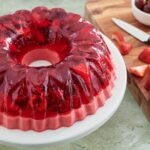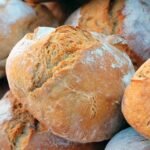
Cornbread is an exemplary solace food that holds an exceptional spot in the hearts of many. Its brilliant outside layer, delicate morsel, and rich flavor make it an ideal side dish or even an independent treat. Whether you’re a carefully prepared cook or a fledgling in the kitchen, this guide will walk you through the most common way of making cornbread in the simplest manner conceivable. We’ll cover all that from choosing the right fixings to baking tips and varieties to suit your taste. Toward the finish of this article, you’ll be prepared to heat a heavenly cornbread that will intrigue loved ones.
1. Figuring out Cornbread: A Short History and Its Varieties
Prior to jumping into the recipe, understanding the underlying foundations of cornbread is fundamental. Cornbread has a rich history in American food, especially in the Southern US. It was a staple nourishment for Local Americans and turned into a critical piece of Southern cooking during the pioneer time frame.
1.1. Conventional Southern Cornbread
Conventional Southern cornbread is commonly made without sugar and has a somewhat brittle surface. It’s cooked in a cast-iron skillet, giving it a fresh hull and a thick, flavorful inside.
1.2. Sweet Northern Cornbread
Conversely, Northern cornbread is many times better and lighter in surface. It’s more cake-like and can be filled in as a sweet or a side dish.
1.3. Cornbread Biscuits and Varieties
Cornbread can likewise be made in biscuit structure or with extra fixings like cheddar, jalapeños, or even bacon for added character.
2. Gathering the Fixings: What You’ll Need
The excellence of cornbread lies in its effortlessness. The fixings are not many and frequently tracked down in many kitchens. You’ll require this:
2.1. Essential Fixings
Cornmeal: The superstar, cornmeal gives cornbread its particular surface and flavor. Yellow cornmeal is most ordinarily utilized, yet white cornmeal is likewise a choice.
Flour: Regular flour helps tie the fixings together and gives design to the cornbread.
Baking Powder: This raising specialist guarantees that the cornbread rises and becomes cushy.
Salt: A touch of salt improves the flavor and balances the pleasantness.
Sugar (discretionary): Contingent upon your inclination, sugar can be added to make the cornbread better.
Eggs: Eggs help in restricting the fixings and add extravagance to the player.
Milk or Buttermilk: Milk adds dampness, while buttermilk gives the cornbread a slight tang and delicacy.
Margarine or Oil: Spread adds a rich flavor, while oil keeps the cornbread wet.
2.2. Discretionary Add-Ins
Cheddar: Destroyed cheddar or mozzarella can be blended into the hitter for a messy turn.
Jalapeños: Diced jalapeños add a zesty kick to the cornbread.
Bacon: Fresh bacon pieces can be added for an exquisite, smoky flavor.
Corn Parts: New or canned corn bits can be blended in for added surface.
3. Bit by bit Guidelines: Making Cornbread the Simple Way
Since we have our fixings prepared, we should continue on toward the bit by bit course of making cornbread.
3.1. Setting up the Skillet or Baking Dish
Picking the Right Container: A cast-iron skillet is customarily utilized for cornbread, yet you can likewise utilize a standard baking dish or biscuit tin.
Preheating the Skillet: If utilizing a cast-iron skillet, preheat it in the broiler to make a firm covering. Oil the skillet with margarine or oil prior to adding the hitter.
3.2. Blending the Dry Fixings
Filter the Cornmeal and Flour: Filtering helps eliminate any knots and guarantees a smooth player.
Join with Baking Powder and Salt: Blend the cornmeal, flour, baking powder, and salt in an enormous bowl until very much consolidated.
3.3. Setting up the Wet Fixings
Whisk the Eggs: In a different bowl, whisk the eggs until they are light and foamy.
Add Milk and Softened Margarine: Gradually add the milk or buttermilk to the eggs, trailed by the liquefied spread or oil. Rush until everything is very much joined.
3.4. Consolidating the Wet and Dry Fixings
Blending the Hitter: Gradually empty the wet fixings into the dry fixings. Mix tenderly until recently consolidated. Be mindful so as not to overmix, as this can make the cornbread thick.
Collapsing in Add-Ins: Assuming that you’re adding cheddar, jalapeños, bacon, or corn parts, crease them into the hitter at this stage.
3.5. Baking the Cornbread
Empty the Hitter into the Skillet: Cautiously empty the player into the preheated skillet or arranged baking dish.
Prepare: Spot the skillet in the stove and heat at 375°F (190°C) for 20-25 minutes, or until the top is brilliant brown and a toothpick embedded into the middle tells the truth.
Cooling: Permit the cornbread to cool in the skillet for a couple of moments prior to cutting and serving.
4. Tips for Wonderful Cornbread Without fail
Cornbread is easy to make, however a couple of tips can assist you with accomplishing flawlessness like clockwork.
4.1. Don’t Overmix the Player
Overmixing can prompt intense, thick cornbread. Mix the fixings just until they are joined.
4.2. Use Buttermilk for Additional Dampness
Buttermilk adds a tart flavor and keeps the cornbread sodden. In the event that you don’t have buttermilk, you can make a substitute by adding a tablespoon of lemon juice or vinegar to some milk.
4.3. Preheat the Skillet
Preheating the skillet guarantees that the cornbread gets a fresh outside layer. Try to lube the skillet a long time prior to pouring in the player.
4.4. Adapting to Pleasantness
Assuming you favor better cornbread, increment how much sugar in the recipe. For a more exquisite variant, discard the sugar through and through.
4.5. Try different things with Add-Ins
Go ahead and get inventive with your cornbread by adding various fixings like cheddar, spices, or flavors. Simply make sure to delicately overlay them into the player.
5. Serving Ideas: Matching Cornbread with Delightful Dishes
Cornbread is inconceivably flexible and can be matched with different dishes. Here are some serving ideas:
5.1. Exemplary Southern Dishes
Cornbread is the ideal side for exemplary Southern dishes like seared chicken, collard greens, and grill ribs.
5.2. Stew and Stews
The slight pleasantness of cornbread supplements the rich kinds of stew, stews, and soups. Serve a cut close by a warm bowl of stew for a generous dinner.
5.3. Breakfast Choice
Cornbread can likewise be delighted in for breakfast. Top it with spread and honey, or serve it with eggs and bacon for a fantastic morning dinner.
5.4. Cornbread Salad
Cornbread can be disintegrated and utilized as a base for a Southern-style salad. Consolidate it with new vegetables, beans, and a tart dressing for a novel and tasty dish.
6. Putting away and Warming Cornbread
On the off chance that you have extras, cornbread can be effectively put away and warmed without losing its surface or flavor.
6.1. Putting away in the Fridge
Wrap the cornbread firmly in cling wrap or store it in a water/air proof holder. It will save in the fridge for as long as seven days.
6.2. Freezing Cornbread
Cornbread freezes well and can be hidden away as long as 90 days. Enclose individual cuts by saran wrap and spot them in a cooler pack.
6.3. Warming Cornbread
To warm, place the cornbread in a preheated broiler at 350°F (175°C) for 10-15 minutes. You can likewise microwave individual cuts for 20-30 seconds.
7. Cornbread Varieties: Investigating Various Flavors and Surfaces
While the customary cornbread recipe is delectable, there are numerous varieties you can attempt to suit your taste buds.
7.1. Jalapeño Cheddar Cornbread
For a zesty wind, add diced jalapeños and destroyed cheddar to the player. This variant coordinates well with bean stew or grill.
7.2. Honey Cornbread
Improve your cornbread by adding honey to the player. This variety is ideal for breakfast or as a sweet.
7.3. Bacon and Corn Cornbread
Fresh bacon pieces and sweet corn portions add an exquisite, sweet, and smoky flavor to the cornbread. Serve it with a side of fried eggs for a delectable informal breakfast.
7.4. Veggie lover Cornbread
For a veggie lover variant, substitute the eggs with flaxseed feast and water, and use almond milk or soy milk rather than customary milk. Supplant the spread with coconut oil or veggie lover margarine.
7.5. Without gluten Cornbread
To make without gluten cornbread, use sans gluten flour or a blend of almond flour and cornstarch. Guarantee that your baking powder and different fixings are additionally sans gluten.
8. Normal Errors to Stay away from While Making Cornbread
Despite the fact that cornbread is not difficult to make, there are a few normal missteps that can influence the end result. This is the way to stay away from them:
8.1. Utilizing Some unacceptable Cornmeal
Try to involve fine or medium-ground cornmeal for the best surface. Coarse cornmeal can make the cornbread abrasive.
8.2. Not Preheating the Skillet
Skirting the step of preheating the skillet can bring about a spongy covering. Continuously preheat your skillet or baking dish prior to adding the hitter.
8.3. Overbaking
Overbaking can dry out the cornbread. Watch out for it during the most recent couple of minutes of baking and eliminate it from the broiler when it’s finished.
8.4. Underseasoning
Cornbread can be dull on the off chance that not prepared as expected. Remember to add salt, and consider adding different flavors or spices for additional character.
9. Cornbread All over the Planet: Global Takes on an Exemplary Dish
While cornbread is a staple in American food, varieties of it tends to be viewed as around the world.
9.1. South American Arepas
Arepas are a kind of cornbread produced using ground maize batter and are famous in Colombia and Venezuela. They are frequently loaded down with cheddar, meats, or avocado.
9.2. African Ugali
Ugali is a cornmeal dish from East Africa. It’s a thick, batter like food that is normally presented with stews and vegetables.
9.3. Italian Polenta
Polenta is a dish produced using bubbled cornmeal and is a staple in Italian food. It tends to be served velvety, similar to porridge, or permitted to set and afterward barbecued or seared.
9.4. Mexican Cornbread
In Mexico, cornbread can appear as tortillas or tamales, the two of which use cornmeal as a base. Mexican cornbread is frequently flavored with chilies and presented with beans and rice.
End: Partake in Your Natively constructed Cornbread
Making cornbread without any preparation is a compensating experience that doesn’t demand a lot of investment or exertion. With the means framed in this aide, you can undoubtedly prepare a flavorful cornbread that suits your taste. Whether you lean toward it sweet or exquisite, plain or with add-ins, cornbread is a flexible dish that can supplement any dinner. In this way, accumulate your fixings, preheat your skillet, and partake in the consoling taste of natively constructed cornbread!





Comments by uzairchippa066@gmail.com